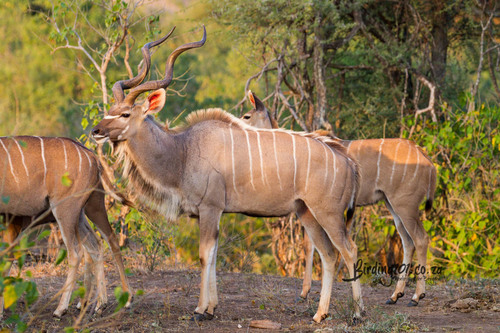
Greater Kudu
The greater kudu, with its majestic spiral horns and striking white stripes, gracefully navigates Africa's savannas. Known for their elusive nature, these browsers play a crucial role in maintaining the balance of their habitat by feeding on foliage and dispersing seeds.
8-14 years
Lifespan
120.0 - 256.0 kg
Weight
Brown, Grey, Red
Color
60 mph
Top Speed
Least Concern
Conservation Status
Stable
Population Trend
Characteristics
Tragelaphus strepsiceros, commonly known as the greater kudu, is notable for its striking spiral horns, which can grow up to 1.8 meters in length. Males are larger and exhibit these impressive horns, while females are hornless. They inhabit savannas, woodlands, and scrublands across southern and eastern Africa and are known for their keen senses, aiding in evading predators. Their diet consists mainly of leaves, shoots, and occasionally fruits, making them important browsers in their ecosystem.
Distribution Range of the Greater Kudu
Tragelaphus strepsiceros, commonly known as the Greater Kudu, is native to eastern and southern Africa. Its geographical distribution spans from Ethiopia and Kenya in the north to South Africa in the south, including countries like Tanzania, Zambia, Zimbabwe, Namibia, Botswana, and Angola. It is commonly found in the savannas, woodlands, and scrublands of these regions.
Greater Kudu's Habitat
Environmental Conditions
The Greater Kudu inhabits a variety of environments ranging from semi-arid areas to savannas and open woodlands. They prefer areas with dense bush or thickets for cover, and they are often found near water sources. The climate in these regions is typically warm, with distinct wet and dry seasons.
Ecological Niche
The Greater Kudu is primarily a browser, feeding on leaves, shoots, and fruits from a variety of shrubs and trees. Its ecological niche involves maintaining the balance of vegetation in its habitat, and it plays a role in seed dispersal. They are adapted to utilizing their long legs and necks to reach higher vegetation that is inaccessible to other herbivores. This species is also known to be quite elusive, using its environment for camouflage to avoid predators like lions and leopards.
Copyright @ Nature Style Limited. All Rights Reserved.
 English
English